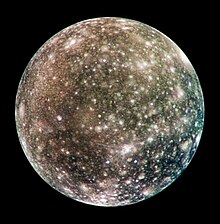Wikijunior:Solar System/Jupiter/Callisto

How big is Callisto?
[edit | edit source]It is Jupiter's second largest moon, after Ganymede, and the third largest moon in the solar system. It is a little more than one third the size of the earth.
What is its surface like?
[edit | edit source]
The surface of Callisto is one of the most cratered in the Solar System. In fact, impact craters are the only features found on the surface. Because Callisto's surface is icy, large craters and mountains are slowly erased. Callisto's crust is about 4 billion years old, dating back to the formation of the Solar System.
The largest crater on the surface is Valhalla. It measures 3000 km across. The second largest crater, Asgard, measures 1600 km across. Gipul Catena, a series of craters in a straight line, was probably caused by an object that was tidally disrupted as it passed close to Jupiter.
There is no oxygen in the atmosphere. Under the rocky crust of the surface there is a salty underground sea.
How long is a day on Callisto?
[edit | edit source]One day on Callisto is equal to approximately 16.7 days on Earth.
Callisto Facts:
- Callisto's crust dates back to the formation of the Solar System.
- A salty ocean may lay beneath the crust.
- It is the second largest of Jupiter's moons.
How long is its orbit around Jupiter?
[edit | edit source]One orbit around Jupiter is also equal to 16.7 days on Earth.
Who is it named after?
[edit | edit source]Callisto (Greek Καλλιστώ) is named after the Greek Mythological nymph named Kallisto, which meant "most beautiful" in Greek. Kallisto was one of Zeus' many lovers.
How was it discovered?
[edit | edit source]Callisto was discovered by Galileo Galilei and Simon Marius. Galileo discovered it on January 7, 1610, and Marius observed it around the same time.
